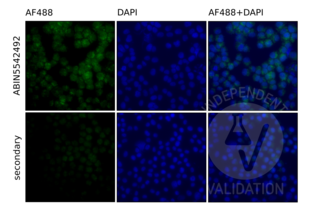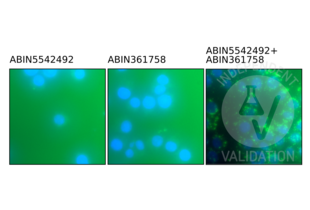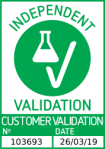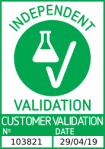TLR9 anticorps (AA 868-1016)
-
- Antigène Voir toutes TLR9 Anticorps
- TLR9 (Toll-Like Receptor 9 (TLR9))
-
Épitope
- AA 868-1016
-
Reactivité
- Humain
-
Hôte
- Souris
-
Clonalité
- Monoclonal
-
Conjugué
- Cet anticorp TLR9 est non-conjugé
-
Application
- Immunohistochemistry (IHC), ELISA, Flow Cytometry (FACS), Immunocytochemistry (ICC)
- Fonction
- TLR9 Antibody
- Purification
- Purified antibody
- Immunogène
- Purified recombinant fragment of human TLR9 (AA: 868-1016) expressed in E. Coli.
- Clone
- 1B12H2
- Isotype
- IgG2a
-
-
- Indications d'application
-
ELISA: 1/10000
FCM: 1/200 - 1/400
ICC: 1/200 - 1/1000
- Restrictions
- For Research Use only
-
- by
- Klinik für Anästhesie, Intensivmedizin und Schmerztherapie, Universitätsklinikum der Ruhr Universität Bochum
- No.
- #103693
- Date
- 26.03.2019
- Antigène
- TLR9
- Numéro du lot
- 160127
- Application validée
- Immunofluorescence
- Contrôle positif
U937 monocytic cells
- Contrôle négative
No primary antibody control
- Conclusion
Passed. ABIN5542492 localization on ER is visible. Negative control without primary antibody shows no signal.
- Anticorps primaire
- ABIN5542492
- Anticorps secondaire
- AF488-conjugated AffiniPure alpaca anti-Mouse IgG antibody (Jackson ImmunoResearch, 615-545-214)
- Full Protocol
- Grow U937 cells in RPMI (Gibco, 21875-034) supplemented with 10% FCS (Gibco, A3840001) and Pen/Strep(Gibco, 15140-122), at 37°C and 5% CO2 in 500µL in 12-well plates.
- Use cytospin to spin cells onto slide.
- Fix cells on coverslide in 4% PFA for 20min at RT.
- Wash cells 3x for 5min with PBS.
- Permeabilize cells in PBS containing 0.1% Triton for 5min at RT.
- Block non-specific binding with Duolink PLA Blocking Solution (Sigma) for 30 min at RT.
- Incubate cells with primary mouse anti-TLR9 antibody (antibodies-online, ABIN5542492, lot 160127) diluted 1:200 in staining solution ON at 4°C.
- Wash cells 3x for 5min with PBS.
- Incubate cells with secondary AF488-conjugated AffiniPure alpaca anti-Mouse IgG antibody (Jackson ImmunoResearch, 615-545-214) diluted 1:400 in staining solution for 1h at RT.
- Wash cells 2x for 5min with PBS.
- Mount coverslips on glass slides in ProLong Gold antifade reagent (Invitrogen, P36935,1890418) containing DAPI.
- Image acquisition with an Olympus widefield microscope.
- Notes
TLR9 staining using ABIN5542492 shows typical localization peri-nuclear localization.
Validation #103693 (Immunofluorescence)![Testé avec succès 'Independent Validation' signe]()
![Testé avec succès 'Independent Validation' signe]() Validation ImagesProtocole
Validation ImagesProtocole -
- by
- Klinik für Anästhesie, Intensivmedizin und Schmerztherapie, Universitätsklinikum der Ruhr Universität Bochum
- No.
- #103821
- Date
- 29.04.2019
- Antigène
- TLR9
- Numéro du lot
- 160127
- Application validée
- Proximity Ligation Assay
- Contrôle positif
U937 monocytic cells stimulated with ODN1826
- Contrôle négative
Anti TLR9 antibody (ABIN5542492) alone
Anti pY antibody (ABIN361758) alone
- Conclusion
Passed. PLA signal visible in stimulated cells. Negative control with only one primary antibody shows no signal.
- Anticorps primaire
- ABIN5542492
- Anticorps secondaire
- ABIN361758
- Full Protocol
- Grow U937 cells in RPMI (Gibco, 21875-034) supplemented with 10% FCS (Gibco, A3840001) and Pen/Strep(Gibco, 15140-122), at 37°C and 5% CO2 in 500µL in 12-well plates.
- Incubate the cells with 1µM ODN1826 for 4h.
- Use cytospin to spin cells onto slide.
- Fix cells on coverslide in 4% PFA for 20min at RT.
- Wash cells 3x for 5min with PBS.
- Permeabilize cells in PBS containing 0.1% Triton for 5min at RT.
- Block non-specific binding with Duolink PLA Blocking Solution (Sigma-Aldrich) for 30min at RT.
- Incubate cells with primary mouse anti-TLR9 antibody (antibodies-online, ABIN5542492, lot 160127) diluted 1:200 and primary rabbit anti-pY antibody (antibodies-online, ABIN361758, lot 1508290) diluted 1:100 ON at 4°C.
- Wash cells 3x for 5min with PBS.
- Incubate cells with Duolink In Situ PLA Probe anti-Rabbit MINUS (Sigma-Aldrich, DUO92005, lot SLBZ4516) and Duolink In Situ PLA Probe anti-Mouse mouse PLUS (Sigma-Aldrich, DUO92001, lot SLBZ8369) proximity probes according to manufacturers recommendations.
- Wash cells 2x for 5min with PBS.
- Perform Ligation step according to the Duolink PLA kit (Sigma).
- Perform Amplification step according to the Duolink In Situ PlA Detection Kit Green (Sigma-Aldrich, DUO92014).
- Mount coverslips on glass slides in ProLong Gold antifade reagent (Invitrogen, P36935, lot 1890418) containing DAPI.
- Image acquisition with an Olympus widefield microscope.
- Notes
We used double the amount the Phi29 polymerase for the amplifaction step than recommended.
Validation #103821 (Proximity Ligation Assay)![Testé avec succès 'Independent Validation' signe]()
![Testé avec succès 'Independent Validation' signe]() Validation ImagesProtocole
Validation ImagesProtocole -
- Format
- Liquid
- Buffer
- Purified antibody in PBS with 0.05 % sodium azide.
- Agent conservateur
- Sodium azide
- Précaution d'utilisation
- This product contains Sodium azide: a POISONOUS AND HAZARDOUS SUBSTANCE which should be handled by trained staff only.
- Stock
- 4 °C,-20 °C
- Stockage commentaire
- Store at 4°C short term. Aliquot and store at -20°C long term. Avoid freeze/thaw cycles.
-
- Antigène
- TLR9 (Toll-Like Receptor 9 (TLR9))
- Autre désignation
- TLR9 (TLR9 Produits)
- Synonymes
- anticorps CD289, anticorps toll like receptor 9, anticorps toll-like receptor 9, anticorps TLR9, anticorps Tlr9
- Sujet
-
Description: The protein encoded by this gene is a member of the Toll-like receptor (TLR) family which plays a fundamental role in pathogen recognition and activation of innate immunity. TLRs are highly conserved from Drosophila to humans and share structural and functional similarities. They recognize pathogen-associated molecular patterns (PAMPs) that are expressed on infectious agents, and mediate the production of cytokines necessary for the development of effective immunity. The various TLRs exhibit different patterns of expression. This gene is preferentially expressed in immune cell rich tissues, such as spleen, lymph node, bone marrow and peripheral blood leukocytes. Studies in mice and human indicate that this receptor mediates cellular response to unmethylated CpG dinucleotides in bacterial DNA to mount an innate immune response.
Aliases: CD289
- Poids moléculaire
- 115.8kDa
- ID gène
- 54106
- HGNC
- 54106
- UniProt
- Q9NR96
- Pathways
- Signalisation TLR, Activation of Innate immune Response, Cellular Response to Molecule of Bacterial Origin, Toll-Like Receptors Cascades
-



 (2 validations)
(2 validations)




